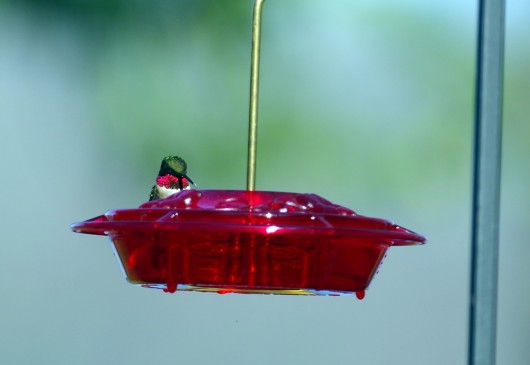This is MIchigan’s only hummingbird. Well, not the only one literally, of course. This is a female Ruby-Throated Hummingbird. Pretty, teeny, and every centimeter feisty. Yesterday a female was sitting on a perch daintily sipping our nectar. A male arrived and she tolerated him. With Michigan so slow to warm this year, and the late bloom of our flowers, they’ve been after anything red. One dive-bombed our red and white cooler while the hatch of the car was open. Another ventured into the garage to check out another red piece of plastic.
Here’s one of the males. They aren’t seen as often at our feeders.
While I was still marveling that the pair wasn’t doing any aerial dueling, a second female arrived on the scene.The female-first-on-the-scene did the hummingbird equivalent of a battle between rival gang members. She sprung up from the feeder perch and began to go at the other female in long, low, u-shaped swoops. During one of the swoops she must have actually struck her rival because the second female sat on the deck rail–unheard of–for a few minutes as if shaking off the effects. She flew off and the female-in-charge returned to her evening meal.
Baltimore Orioles are preferring the hummingbird feeder to the navel orange we’ve halved and hung on a feeder pole. They’ve picked at the orange but are apparently preferring the sweet liquid this weekend.
The Orioles approach cautiously.
They settle on the perch, spilling some nectar from the feeder when it’s filled.
Then they sort of do the bird equivalent of a forward bend and drink. But in between sips, it’s like their head is on a swivel. I think they are on the watch for the female hummers, who seem to have no sense of their size relative to other birds.






